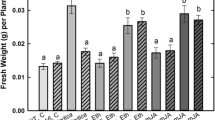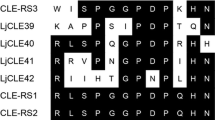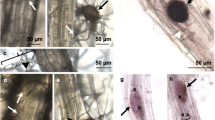Abstract
Key message
This study focused on the role of CLE1–7 peptides as defense mediators, and showed that root-expressed CLE3 functions as a systemic signal to regulate defense-related gene expression in shoots.
Abstract
In the natural environment, plants employ diverse signaling molecules including peptides to defend themselves against various pathogen attacks. In this study, we investigated whether CLAVATA3/EMBRYO SURROUNDING REGION-RELATED (CLE) genes (CLE1–7) respond to biotic stimuli. CLE3 showed significant up-regulation upon treatment with flg22, Pep2, and salicylic acid (SA). Quantitative real-time PCR (qRT-PCR) analysis revealed that CLE3 expression is regulated by the NON-EXPRESSOR OF PR GENES1 (NPR1)-dependent SA signaling and flg22–FLAGELLIN-SENSITIVE 2 (FLS2) signaling pathways. We demonstrated that SA-induced up-regulation of CLE3 in roots was required for activation of WRKY33, a gene involved in the regulation of systemic acquired resistance (SAR), in shoots, suggesting that CLE3 functions as a root-derived signal that regulates the expression of defense-related genes in shoots. Microarray analysis of transgenic Arabidopsis lines overexpressing CLE3 under the control of a β-estradiol-inducible promoter revealed that root-confined CLE3 overexpression affected gene expression in both roots and shoots. Comparison of CLE2- and CLE3-induced genes indicated that CLE2 and CLE3 peptides target a few common but largely distinct downstream genes. These results suggest that root-derived CLE3 is involved in the regulation of systemic rather than local immune responses. Our study also sheds light on the potential role of CLE peptides in long-distance regulation of plant immunity.







Similar content being viewed by others
Data Availability
Microarray data generated in this study were deposited to the National Center for Biotechnology Information (NCBI) Gene Expression Omnibus (GEO) database under the accession number GSE176064. Web link; https://www.ncbi.nlm.nih.gov/geo/query/acc.cgi?acc=GSE176064.
Code availability
Not applicable.
References
Ádám AL, Nagy ZÁ, Kátay G, Mergenthaler E, Viczián O (2018) Signals of systemic immunity in plants: progress and open questions. Int J Mol Sci 19:1146
Araya T, Miyamoto M, Wibowo J, Suzuki A, Kojima S, Tsuchiya YN, Sawa S, Fukuda H, Wirén NV, Takahashi H (2014) CLE-CLAVATA1 peptide-receptor signaling module regulates the expansion of plant root systems in a nitrogen-dependent manner. Proc Natl Acad Sci USA 111:2029–2034
Baena-González E, Rolland F, Thevelein JM, Sheen J (2007) A central integrator of transcription networks in plant stress and energy signalling. Nature 448:938–942
Beckers GJ, Jaskiewicz M, Liu Y, Underwood WR, He SY, Zhang S, Conrath U (2009) Mitogen-activated protein kinases 3 and 6 are required for full priming of stress responses in Arabidopsis thaliana. Plant Cell 21:944–953
Bethke G, Unthan T, Uhrig JF, Pöschl Y, Gust AA, Scheel D, Lee J (2009) Flg22 regulates the release of an ethylene response factor substrate from MAP kinase 6 in Arabidopsis thaliana via ethylene signaling. Proc Natl Acad Sci USA 106:8067–8072
Betsuyaku S, Katou S, Takebayashi Y, Sakakibara H, Nomura N, Fukuda H (2018) Salicylic acid and jasmonic acid pathways are activated in spatially different domains around the infection site during effector-triggered immunity in Arabidopsis thaliana. Plant Cell Physiol 59:8–16
Cao H, Glazebrook J, Clarke JD, Volko S, Dong X (1997) The Arabidopsis NPR1 gene that controls systemic acquired resistance encodes a novel protein containing ankyrin repeats. Cell 88:57–63
Chen YC, Holmes EC, Rajniak J, Kim JG, Tang S, Fischer CR, Mudgett MB, Sattely ES (2018) N-hydroxy-pipecolic acid is a mobile metabolite that induces systemic disease resistance in Arabidopsis. Proc Natl Acad Sci USA 115:E4920–E4929
Chinchilla D, Bauer Z, Regenass M, Boller T, Felix G (2006) The Arabidopsis receptor kinase FLS2 binds flg22 and determines the specificity of flagellin perception. Plant Cell 18:465–476
Curtis MD, Grossniklaus U (2003) A gateway cloning vector set for high-throughput functional analysis of genes in planta. Plant Physiol 133:462–469
Denoux C, Galletti R, Mammarella N, Gopalan S, Werck D, De Lorenzo G, Ferrarri S, Ausubel FM, Dewdney J (2008) Activation of defense response pathways by OGs and Flg22 elicitors in Arabidopsis seedlings. Mol Plant 1:423–445
Dodds PN, Rathjen JP (2010) Plant immunity: towards an integrated view of plant–pathogen interactions. Nat Rev Genet 11:539–548
Fu ZQ, Dong X (2013) Systemic acquired resistance: turning local infection into global defense. Annu Rev Plant Biol 64:839–863
Gómez-Gómez L, Boller T (2000) FLS2: An LRR receptor–like kinase involved in the perception of the bacterial elicitor flagellin in Arabidopsis. Mol Cell 5:1003–1011
Gómez-Gómez L, Felix G, Boller T (1999) A single locus determines sensitivity to bacterial flagellin in Arabidopsis thaliana. Plant J 18:277–284
Hanemian M, Barlet X, Sorin C, Yadeta KA, Keller H, Favery B, Simon R, Thomma BPHJ, Hartmann C, Crespi M, Marco Y, Tremousaygue D, Deslandes L (2016) Arabidopsis CLAVATA 1 and CLAVATA 2 receptors contribute to Ralstonia solanacearum pathogenicity through a miR169-dependent pathway. New Phytol 211:502–515
Huang DW, Sherman BT, Zheng X, Yang J, Imamichi T, Stephens R, Lempicki RA (2009) Extracting biological meaning from large gene lists with DAVID. Curr Protoc Bioinformatics 27:11–13
Jun J, Fiume E, Roeder AH, Meng L, Sharma VK, Osmont KS, Baker C, Ha CM, Meyerowitz EM, Feldman LJ, Fletcher JC (2010) Comprehensive analysis of CLE polypeptide signaling gene expression and overexpression activity in Arabidopsis. Plant Physiol 154:1721–1736
Kim Y, Tsuda K, Igarashi D, Hillmer RA, Sakakibara H, Myers CL, Katagiri F (2014) Mechanisms underlying robustness and tunability in a plant immune signaling network. Cell Host Microbe 15:84–94
Kubo M, Udagawa M, Nishikubo N, Horiguchi G, Yamaguchi M, Ito J, Mimura T, Fukuda H, Demura T (2005) Transcription switches for protoxylem and metaxylem vessel formation. Genes Dev 19:1855–1860
Kucukoglu M, Nilsson O (2015) CLE peptide signaling in plants–the power of moving around. Physiol Plant 155:74–87
Lippok B, Birkenbihl RP, Rivory G, Brümmer J, Schmelzer E, Logemann E, Somssich IE (2007) Expression of AtWRKY33 encoding a pathogen-or PAMP-responsive WRKY transcription factor is regulated by a composite DNA motif containing W box elements. Mol Plant Microbe Interact 20:420–429
Ma D, Endo S, Betsuyaku S, Shimotohno A, Fukuda H (2020) CLE2 regulates light-dependent carbohydrate metabolism in Arabidopsis shoots. Plant Mol Biol 104:561–574
Murray SL, Ingle RA, Petersen LN, Denby KJ (2007) Basal resistance against Pseudomonas syringae in Arabidopsis involves WRKY53 and a protein with homology to a nematode resistance protein. Mol Plant Microbe Interact 20:1431–1438
Návarová H, Bernsdorff F, Döring A-C, Zeier J (2012) Pipecolic acid, an endogenous mediator of defense amplification and priming is a critical regulator of inducible plant immunity. Plant Cell 24(12):5123–5141. https://doi.org/10.1105/tpc.112.103564
Nawrath C, Heck S, Parinthawong N, Métraux JP (2002) EDS5, an essential component of salicylic acid-dependent signaling for disease resistance in Arabidopsis, is a member of the MATE transporter family. Plant Cell 14:275–286
Nicaise V, Roux M, Zipfel C (2009) Recent advances in PAMP-triggered immunity against bacteria: pattern recognition receptors watch over and raise the alarm. Plant Physiol 150:1638–1647
Ohashi-Ito K, Saegusa M, Iwamoto K, Oda Y, Katayama H, Kojima M, Sakakibara H, Fukuda H (2014) A bHLH complex activates vascular cell division via cytokinin action in root apical meristem. Curr Biol 24:2053–2058
Ohashi-Ito K, Iwamoto K, Nagashima Y, Kojima M, Sakakibara H, Fukuda H (2019) A positive feedback loop comprising LHW–TMO5 and local Auxin biosynthesis regulates initial vascular development in Arabidopsis roots. Plant Cell Physiol 60:2684–2691
Okamoto S, Ohnishi E, Sato S, Takahashi H, Nakazono M, Tabata S, Kawaguchi M (2009) Nod factor/nitrate-induced CLE genes that drive HAR1- mediated systemic regulation of nodulation. Plant Cell Physiol 50:67–77
Okamoto S, Shinohara H, Mori T, Matsubayashi Y, Kawaguchi M (2013) Root-derived CLE glycopeptides control nodulation by direct binding to HAR1 receptor kinase. Nat Commun 4:2191
Pieterse CM, Van der Does D, Zamioudis C, Leon-Reyes A, Van Wees SC (2012) Hormonal modulation of plant immunity. Annu Rev Cell Dev Biol 28:489–521
Ross, A., Yamada, K., Hiruma, K., Yamashita-Yamada, M., Lu, X., Takano, Y., Tsuda, K. and Saijo, Y. (2013). The Arabidopsis PEPR pathway couples local and systemic plant immunity. EMBO J. e201284303.
Takahashi F, Suzuki T, Osakabe Y, Betsuyaku S, Kondo Y, Dohmae N, Fukuda H, Yamaguchi-Shinozaki K, Shinozaki K (2018) A small peptide modulates stomatal control via abscisic acid in long-distance signalling. Nature 556:235–238
Tsuda K, Sato M, Glazebrook J, Cohen JD, Katagiri F (2008) Interplay between MAMP-triggered and SA-mediated defense responses. Plant J 53:763–775
Vlot AC, Dempsey DMA, Klessig DF (2009) Salicylic acid, a multifaceted hormone to combat disease. Annu Rev Phytopathol 47:177–206
Wang Y, Schuck S, Wu J, Yang P, Döring AC, Zeier J, Tsuda K (2018) A MPK3/6-WRKY33-ALD1-pipecolic acid regulatory loop contributes to systemic acquired resistance. Plant Cell 30:2480–2494
Xiao S, Chye ML (2011) Overexpression of Arabidopsis ACBP3 enhances NPR1-dependent plant resistance to Pseudomonas syringe pv tomato DC3000. Plant Physiol 156:2069–2081
Xiao S, Gao W, Chen QF, Chan SW, Zheng SX, Ma J, Wang M, Welti R, Chye ML (2010) Overexpression of Arabidopsis acyl-CoA binding protein ACBP3 promotes starvation-induced and age-dependent leaf senescence. Plant Cell 22:1463–1482
Yi SY, Min SR, Kwon SY (2015) NPR1 is Instrumental in Priming for the Enhanced flg22-induced MPK3 and MPK6 Activation. Plant Pathol J 31:192–194
Zheng Z, Qamar SA, Chen Z, Mengiste T (2006) Arabidopsis WRKY33 transcription factor is required for resistance to necrotrophic fungal pathogens. Plant J 48:592–605
Zipfel C, Robatzek S, Navarro L, Oakeley EJ, Jones JD, Felix G, Boller T (2004) Bacterial disease resistance in Arabidopsis through flagellin perception. Nature 428:764–767
Zipfel C, Kunze G, Chinchilla D, Caniard A, Jones JD, Boller T, Felix G (2006) Perception of the bacterial PAMP EF-Tu by the receptor EFR restricts Agrobacterium-mediated transformation. Cell 125:749–760
Acknowledgements
We thank Kyoko Ohashi-Ito and Taku Demura for providing the transgenic plants used in this study and pBGYN vector, respectively. We appreciate Yusuke Saijo, Kenichi Tsuda and Imre Somsich for sharing the seeds used in this study. We also thank Yukiko Sugisawa, Yumi Suzuki, Masakazu Ota, and Kuninori Iwamoto for technical assistance.
Funding
This work was supported in part by Grant-in-Aid from the Ministry of Education, Culture, Sports, Science and Technology (15H05958 to HF); Japan Society for the Promotion of Science (21H02500 to HF); PRESTO (117665 to SB) and ERATO (JPMJER1502 to SB) from Japan Science and Technology Agency; and JPNP18016 (to SB) commissioned by New Energy and Industrial Technology Development Organization (NEDO).
Author information
Authors and Affiliations
Contributions
DM, SE, EB, SB, and HF designed the research; DM, SE, EB, and SB performed the experiments; and DM, SE, TF, SB, and HF wrote the manuscript.
Corresponding authors
Ethics declarations
Conflict of interest
The authors declare that they have no conflict of interest.
Consent to participate
Not applicable.
Consent for publication
Not applicable.
Additional information
Publisher's Note
Springer Nature remains neutral with regard to jurisdictional claims in published maps and institutional affiliations.
Supplementary Information
Below is the link to the electronic supplementary material.
Rights and permissions
About this article
Cite this article
Ma, D., Endo, S., Betsuyaku, E. et al. Root-specific CLE3 expression is required for WRKY33 activation in Arabidopsis shoots. Plant Mol Biol 108, 225–239 (2022). https://doi.org/10.1007/s11103-021-01234-9
Received:
Accepted:
Published:
Issue Date:
DOI: https://doi.org/10.1007/s11103-021-01234-9




